The Loneliness Epidemic
How the Silent Loss of Social Connection has Impacted Our Communities During COVID-19
2021 YMCA WorkWell Special Issue Report
Introduction
The Harvard Study of Adult Development is one of the longest running studies of people and what it is that makes us live long, happy lives. The study began during the Great Depression in 1938 and has extensively tracked the lives of 724 people and their 2,000 children over the last 80 years, looking for clues about what truly leads to health and happiness. In 1938, researchers predicted that the happiest and healthiest people would be those with a high IQ, strong physical genes, a favourable social class, and the right mix of personality traits.
Were they ever wrong! The best and most consistent predictor of long and happy lives wasn’t social class, physical health, IQ, or genes – it was social connection. Through decades of research, this study has shown how healthy relationships help us through hardships, strengthen our immune system, and delay mental and physical declines. Studies have shown that a lack of social connection over time affects our health more than smoking, obesity, and high blood pressure - even suggesting that prolonged loneliness can have the same effect on our health as smoking 15 cigarettes a day. This has led many social scientists to herald social connection as our single greatest need after food and shelter.
Worryingly, loneliness has been a silent struggle in our community for years. A 2019 report on well-being in Waterloo Region found that 24% of residents felt that they lacked companionship and 20% felt isolated from others in the community. To put that into perspective: 1 in 4 people you passed in the grocery store felt lonely in 2019; 1 in 5 people in your organization felt isolated as community members. These were staggering and worrying numbers that deserved our attention.
And then COVID-19 hit.
Overnight, the pandemic changed how we interact with our family, our friends, and our community. Our relationships suddenly became virtual – we saw family through Zoom instead of around a dinner table; we caught up with colleagues through scheduled virtual meetings instead of organic conversations around the water cooler; we engaged with our friends and community through social media instead of vibrant cultural events. Important social events like weddings, funerals, fundraisers, and sporting events were rescheduled or cancelled altogether.
We know social connection matters and we have decades of research to back it up. And yet in a community already in need of connection, COVID-19 has made it more difficult than ever. At the YMCA of Three Rivers, connection is in our DNA, so we went out to collect our own data. We distributed an anonymous, online survey with the goal of understanding a few critical questions: (1) How have loneliness and well-being changed during COVID-19? (2) What is the current state of loneliness and well-being in our community? and (3) Just how closely are the two linked?
We received feedback from 1,453 residents in Guelph-Wellington, Stratford Perth, and Waterloo Region between February 22 and March 22, 2021. The survey was distributed through YMCA newsletters, through social media and through many of our amazing community partners, with responses coming from a wide range of backgrounds, identities, ages, and socio-economic statuses. Importantly, this survey was not limited to YMCA members. Over two thirds of responses came from community members who have not used any YMCA programming in the last year. This data is about connection within our entire community – something that has always been our top priority.
In this YMCA WorkWell Special Issue Report, we’ll highlight our key findings on loneliness in our YMCA of Three Rivers communities during COVID-19, how it has affected residents’ well-being, and provide some places to start to inject connection back into your community. You’re not in this alone and neither are we.
The Loneliness Epidemic in our Communities
The pandemic has shaken our ability to connect with others – it has limited physical proximity and physical touch, masks have covered informative facial expressions, and many at-risk and concerned community members have felt unsafe simply walking out their front door. But just how significant have these changes to our day-to-day life been in terms of connection in our community? Our data suggests that the loneliness epidemic is real and it is here.
Has COVID-19 Increased Loneliness?
While loneliness was an issue in our communities before the pandemic, we wanted to begin by understanding if COVID-19 has affected loneliness in our communities with one simple question: Have people felt lonelier than normal during the pandemic? Figure 1 highlights respondents’ answers to this question.

Figure 1.
70% of respondents – a strong majority - agreed that they have felt lonelier than normal during the pandemic, while only 13% disagreed with this statement. These results may not be surprising given the challenges of this past year, but their magnitude is striking. With almost one million residents between our communities of Waterloo Region, Guelph-Wellington, and Stratford-Perth, this provides early evidence of just how much has changed in our social connection in the past year. In the next section, we dig deeper to understand what this could mean for our residents in a more practical sense.
Breaking Down Social Connection During COVID-19
The next question we wanted to understand is how do these changes look in day-to-day life? For example – someone might feel lonelier than normal during COVID-19, but that does not mean that they are lonely. To better understand the current state of loneliness in our communities, we focused on two indicators of respondents’ connection to their community and two indicators of connection in their personal relationships in the past three months.
COMMUNITY CONNECTION
I have felt like a valued member of my community.
I have felt like my community accepts me for who I am.
PERSONAL CONNECTION
I have felt like I am getting the support I need from my personal relationships.
I have felt like I have people to turn to if I need help.
These four questions were asked on a 100-point scale, with higher scores indicating more positive responses and lower scores indicating more negative responses. To help visualize and understand the data at a community level, we have categorized respondents’ scores into three different groups: Healthy, Adequate, and Unhealthy.
Figure 2 illustrates the breakdown in social connection scores for all respondents who have experienced an increased sense of loneliness during COVID-19.
Figure 2. Full breakdown of scores on community and personal connection questions.
It is important to note that despite feeling lonelier than normal during COVID-19, many respondents are still reporting healthy levels of connection. For example, 51% believe that they have people to turn to if they need help, 48% feel accepted by the community for who they are, and 39% strongly believe that they are getting the support they need from their personal relationships. This suggests that even despite the challenges presented by the pandemic, many people are still fortunate enough to be experiencing healthy levels of connection in their day-to-day lives.
Not all are so lucky, however. Over half of respondents do not feel like a valued member of their community, 37% are not getting the support they need from their personal relationships, and 32% do not feel like their community accepts them for who they are. When you consider that loneliness can be worse for our long-term health than smoking, these numbers speak to a significant community-level need.
 Understanding Community Needs
Understanding Community Needs
We have established that a strong majority of respondents in our community feel lonelier than normal during COVID-19 and a sizeable percentage are also experiencing an unhealthy lack of social connection. The final piece of the puzzle is understanding how our need for connection compares to other needs during the pandemic.
To help address this question, we provided all respondents with a list of 26 different needs, including an open-ended “Other” option (see Appendix A for the full list of needs provided in the survey). Respondents were then asked to select every option that they believe they need more of in the next three months to support their personal well-being. These community needs were then ranked to illustrate which needs were identified by the most people.
Of those options, connection with friends and connection with family were far and away the most commonly identified needs, selected by 75% and 60% of respondents respectively (see Figure 3). Other social needs such as connection with community (38%), connection with colleagues (27%), and simply someone to talk to (18%) were also clear community needs. These five were the only connection-based needs in the full list of 26 needs provided to respondents, and yet they were all ranked in the top half of the most commonly identified needs (see Appendix B for a list of the top 12 needs identified by respondents).

Figure 3. Percentage of respondents identifying each need as something they need more of in the next three months to support their personal well-being.
Overall, these results provide a compelling case: Our community is in dire need of connection. Most people have felt lonelier than normal during COVID-19, many are experiencing an unhealthy lack of social connection, and every form of connection was among the most commonly cited needs in our community. These are stark numbers – but what do they mean? In the next section, we will provide a similar look at the state of well-being in our community and how it has changed during the pandemic.
Well-Being in Our Communities
Our purpose at the YMCA of Three Rivers is to make our diverse communities healthier and more vibrant. This is why it has been so important to us at the YMCA of Three Rivers and YMCA WorkWell to understand well-being in our community and to identify the best ways for our YMCA and other inspired organizations to effectively promote it.
COVID-19 has clearly had a direct effect on the physical health of those who have contracted it; the virus has directly impacted thousands of residents in our YMCA of Three Rivers community and indirectly impacted thousands more. However, it has also had a widespread effect on many other facets of community health – our mental health, financial health, social health, occupational health, and our overall well-being – and the feedback from our community highlights this impact.
High-Level Results: Understanding the COVID-Effect on Well-Being
Similar to loneliness, we wanted to start at the highest level when understanding the state of well-being in our community with one simple question: Do respondents believe that COVID-19 has had a negative impact on their personal well-being? Figure 4 illustrates how the answer was a resounding yes.
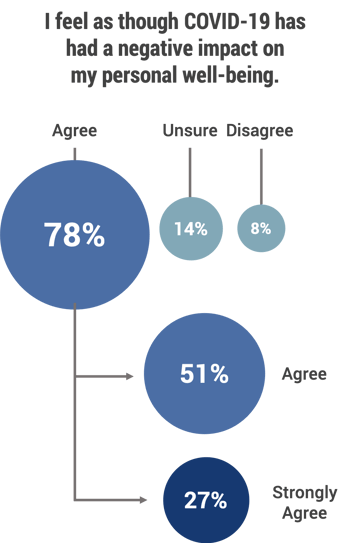
Figure 4
78% of respondents believe that COVID-19 has had a negative impact on their personal well-being, and only 8% believe that they’re at least as healthy as they were at the start of the pandemic. These numbers may seem expected, but it is rare for an event to have such a widespread, prolonged effect on our community. But what does this mean for community well-being day-to-day? We start to see more nuance as we begin to examine different types of health.
Breaking Down Well-Being During COVID-19
Similar to loneliness, we have illustrated how the vast majority of respondents believe that COVID-19 has had a negative impact on their personal well-being, but that does not necessarily mean that they are feeling unhealthy. In this section, we dive deeper into the current state of well-being in our Three Rivers community by examining respondents’ scores on general well-being, mental health, physical health, and family health.
To provide context, we have been able to compare these indicators of health across three different community surveys over the past 16 months to examine how community well-being has changed since the start of the pandemic. Table 1 provides some additional information on these surveys – including the number of respondents, when the survey was live, and which questions were present in each survey to be able to track community scores over time.
|
December 2019 1198 Working Adults |
August 2020 1184 Working Adults |
March 2021 1453 Adults |
Similar to the social connection indicators above, all questions were asked on a 100-point scale and we have categorized respondents’ scores into three different groups: Healthy, Adequate, and Unhealthy. Figure 5 illustrates the breakdown of all respondents’ scores over the past 16 months.
Figure 5. Breakdown of well-being scores since the start of COVID-19.
Comparing community well-being across these three surveys demonstrates the ways in which COVID-19 continues to have significant effects on the well-being of residents. For example, before COVID-19, over 50% of residents surveyed had healthy general well-being scores, with 22% of respondents scoring as unhealthy – a number that even seemed too high in 2019. By August 2020, however, five months into the pandemic, those numbers had changed significantly. The number of respondents with healthy general well-being scores dropped by more than half to 23% and the number of respondents with unhealthy scores more than doubled to 46%.
While we do not have pre-COVID benchmarks for these other health indicators, the high correlations between our measures of general well-being and mental health (r = .85, p < .001), physical health (r = .71, p < .001), and family health (r = .60, p < .01) suggest that similar declines were also likely seen in these areas from pre-COVID levels. In other words: When general well-being falls, we typically see mental, physical, and family health fall too.
Now in 2021, a new and important story in community well-being has emerged –specifically, how stable these low well-being scores have been a full year into the pandemic. These low general well-being scores have remained virtually unchanged since the summer, and we continue to see unhealthy scores in general well-being, mental health, and physical health in nearly half of respondents. While family health continues to see healthier numbers, we continue to see unhealthy scores in over a quarter of respondents here too.
| 22% | of respondents had unhealthy general well-being scores in | 2019 |
| 46% | of respondents had unhealthy general well-being scores in | 2020 |
| 45% | of respondents had unhealthy general well-being scores in | 2021 |
These numbers paint a worrying story: The percentage of residents struggling with their well-being has seemingly doubled during COVID-19 and this does not seem to be letting up one year into the pandemic.
Community Needs and Stressors
What does this look like on the ground in our community? The community needs and stressors sections of this survey provide some important insights. For example, 24% of all respondents identified a clear need for improved mental health supports in the next three months in order to better support their personal well-being.
It was in the data on community stressors, however, that we saw the most compelling results. Similar to the question on community needs, we provided respondents with a list of 22 significant stressors that they might have experienced in the last year and asked respondents to select every stressor that they have personally experienced since the start of COVID-19 (see Appendix B for full list of stressors).
Of the 22 stressors provided, significant mental health challenges were identified more than any option on the list – with 32% of all respondents saying that they experienced significant mental health challenges in the last year.
| 32% | of respondents experienced significant mental health challenges in the last year |
| 24% | of respondents cited a need for better mental health supports in the next 3 months |
These community-level numbers are striking, but mental health challenges are even more prevalent amongst some notable at-risk groups (see Figure 6). For example, 67% of student respondents identified significant mental health challenges, along with 51% of those currently unemployed. This is particularly important as many of these groups do not have accessible and affordable access to the mental health support they need. While improved access to mental health supports is a clear need across the entire community, these are groups with a particularly strong need for bolstered supports that are accessible, affordable, and effective.

Figure 6. Percentage of respondents in notable at-risk groups identifying significant mental health challenges in the past year.
Overall, we are now one year into the pandemic and well-being scores in our community continue to be a significant concern. Respondents resoundingly believe that COVID-19 has had a negative impact on their personal well-being, with many respondents experiencing significant mental health challenges and mental health needs in the past year. Rather than the start of a well-being recovery we have all hoped for, we have only seen well-being scores remain consistent with those seen in the summer of 2020 – scores that were well below pre-COVID levels. This is a notable, ongoing challenge for our community and in the next section, we outline how a decline in social connection during COVID-19 has played a critical role in these challenges.
Connection & Well-Being: Putting the Pieces Together
So far, we’ve highlighted the prevalence of loneliness in our communities. We’ve also seen the challenges people have faced with their well-being and mental health in the last year. But how are these two linked? Just how influential has loneliness been in shaping the well-being of our residents and what can we learn from these relationships to help us rebuild social connection? In this section, we put the pieces together to highlight just how critical social connection is.
High-Level Results: Understanding the Joint Covid-Effect
In order to start at the highest level and understand how loneliness has influenced well-being during the pandemic, we wanted to know: Do respondents believe that feelings of social isolation have had a negative effect on their personal well-being during COVID-19? Figure 7 breaks down the responses to this question.
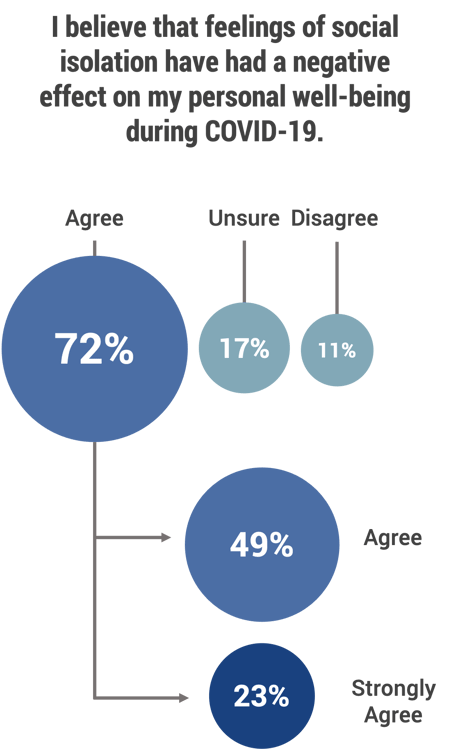
Figure 7.
72% of respondents believe that feelings of social isolation have had a negative effect on their personal well-being during COVID-19 – a significant majority - and only 11% disagree with that statement. These are early signs of how closely intertwined connection and well-being are, and in the following section we dig deeper into just how important connection is to our well-being and mental health.
Digging Deeper: Loneliness and Mental Health
Our next step in understanding this connection was to dig deeper into the well-being of those respondents who believe that they have felt lonelier than normal during the pandemic. Specifically, we compared the well-being and mental health of those who agreed with the statement “I have felt lonelier than normal during COVID-19” to those who disagreed. While the group who has felt lonelier than normal was significantly larger - making up 70% of all respondents - there were notable differences between the two groups across a number of well-being indicators. Figure 8 illustrates some of these key differences.
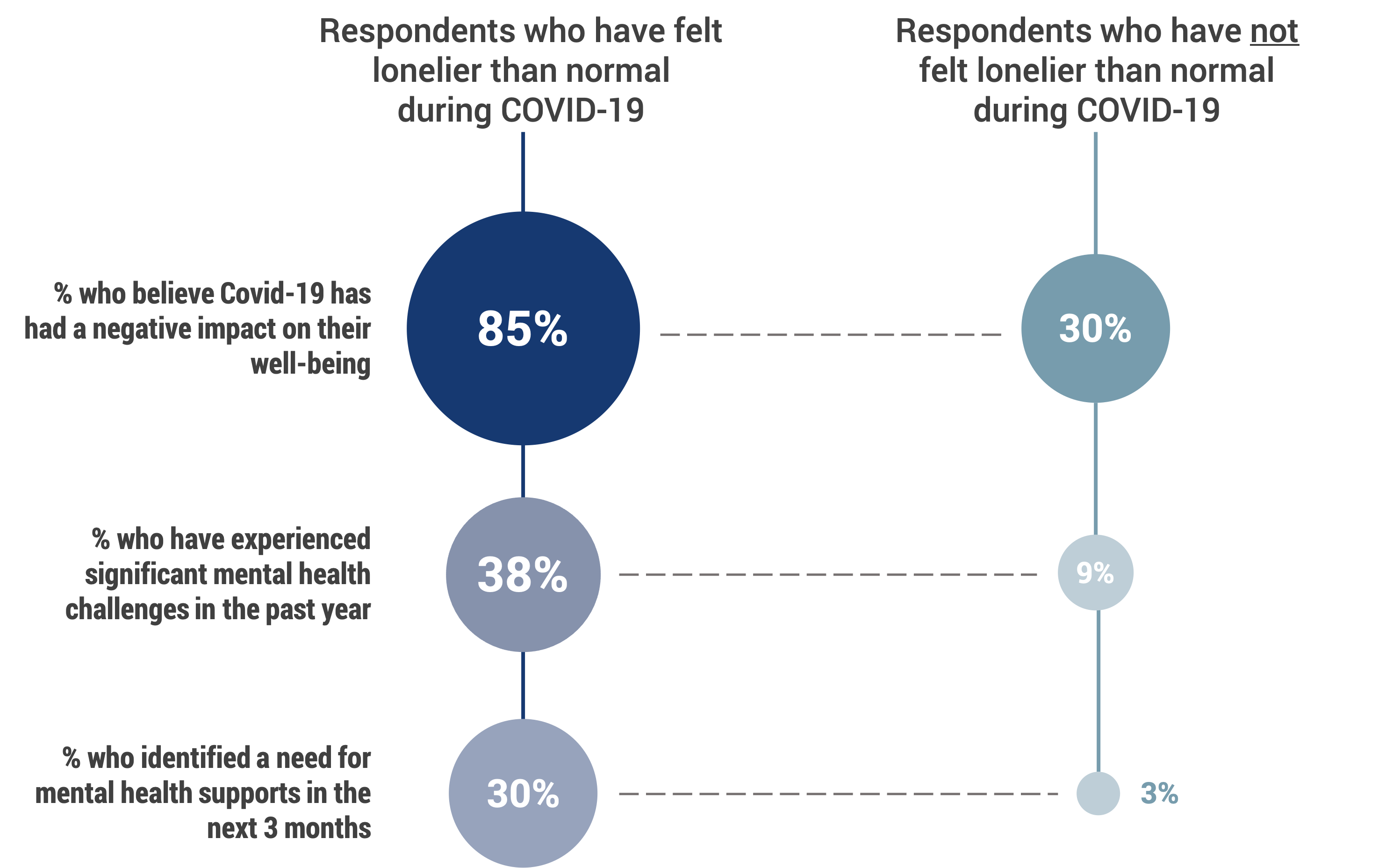
Figure 8. Comparing differences in well-being by loneliness experienced during COVID-19.
These numbers illustrate some of the clear implications of feeling lonelier than normal in the past year. For example, those who have felt like they are lacking social connection during the pandemic are almost 3x more likely to believe that COVID-19 has had a negative impact on their personal well-being, 4x more likely to have experienced significant mental health challenges in the past year, and 10x more likely to report a need for better mental health supports in the next three months.
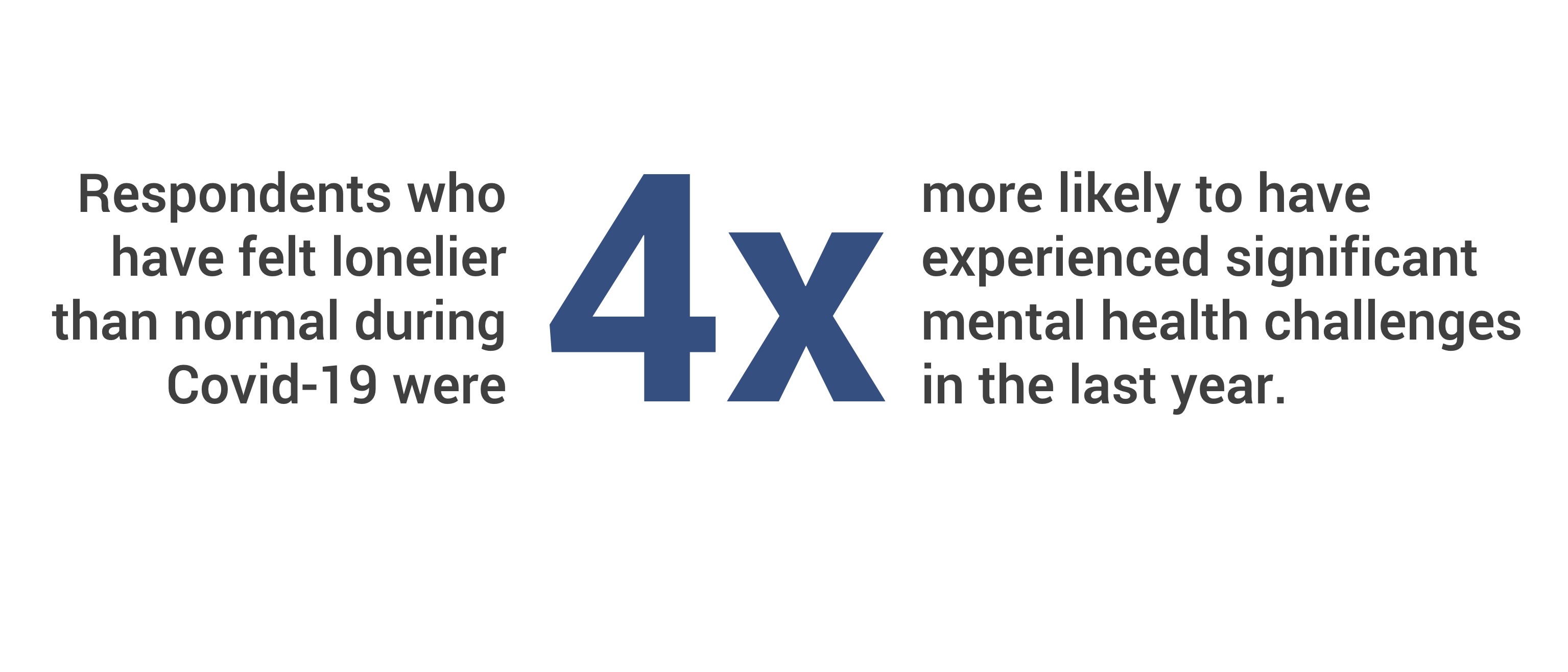 As one further piece of evidence, we also examined average general well-being and mental health scores by whether respondents did or did not feel lonelier than normal during COVID-19. Unsurprisingly, these results showed a similar effect (see Figure 9).
As one further piece of evidence, we also examined average general well-being and mental health scores by whether respondents did or did not feel lonelier than normal during COVID-19. Unsurprisingly, these results showed a similar effect (see Figure 9).
Figure 9. Comparing mental health scores (1-100) by loneliness experienced during COVID-19. These differences were statistically significant; F(1,935) = 207.65, p < .001.
Highlighting the true impact of loneliness, mental health scores for those who have felt lonelier than normal during COVID-19 are more than 30-points lower than those who have not felt lonelier than normal – declining from a healthy score of 83 to an unhealthy score of 52. It’s important to note that while these findings demonstrate the power of loneliness, they also clearly highlight the benefits of social connection. Respondents who have been able to maintain their levels of social connection during the pandemic were the only group in the data with healthy well-being scores on average. They might be a small minority - only 13% of respondents have not felt lonelier than normal during COVID-19 – but this points to an important reminder: Connection can support our well-being and mental health and, critically, it is not impossible to find during the pandemic.
In the next section, we examine how healthy community and personal connection can support our mental health and make a serious impact in our community as we look to recover long-term from the pandemic.
Supporting Mental Health Through Healthy Connection
While the majority of respondents have felt lonelier than normal during the pandemic, this data suggests that there are many people still experiencing healthy levels of social connection in their community and in their personal relationships. How does the mental health of these respondents compare to those who have struggled to feel connected? And how well does social connection support our mental health? In Figure 11, we compare average mental health scores of respondents with healthy community connection scores to respondents with unhealthy community connection scores.
Figure 11. Average mental health scores (1-100) by healthy and unhealthy levels of community connection.
Our community matters. And these results suggest that healthy community connection can play a powerful role in protecting our mental health. Specifically, respondents’ average mental health scores were significantly higher amongst those who feel like a valued member of their community (t(801) = 17.17, p < .001) and feel like their community accepts them for who they are (t(815) = 18.48, p < .001). Importantly, Figure 12 illustrates how connection within our personal relationships can be just as powerful.
Figure 12. Average mental health scores (1-100) by healthy and unhealthy levels of personal connection.
Similar to community connection, average mental health scores were significantly higher for respondents who feel like they are getting the support they need from their personal relationships (t(858) = 20.14, p < .001) and feel like they have someone to turn to if they need help (t(900) = 18.31, p < .001). Together, these results suggest that healthy levels of community and personal connection can also help support healthier levels of mental health. As the final piece of the puzzle, we wanted to understand if respondents’ experience of healthy connection can prevent mental health challenges as well as promote positive mental health. In Figure 13, we compare the percentage of respondents who have experienced significant mental health challenges by healthy and unhealthy levels of social connection.
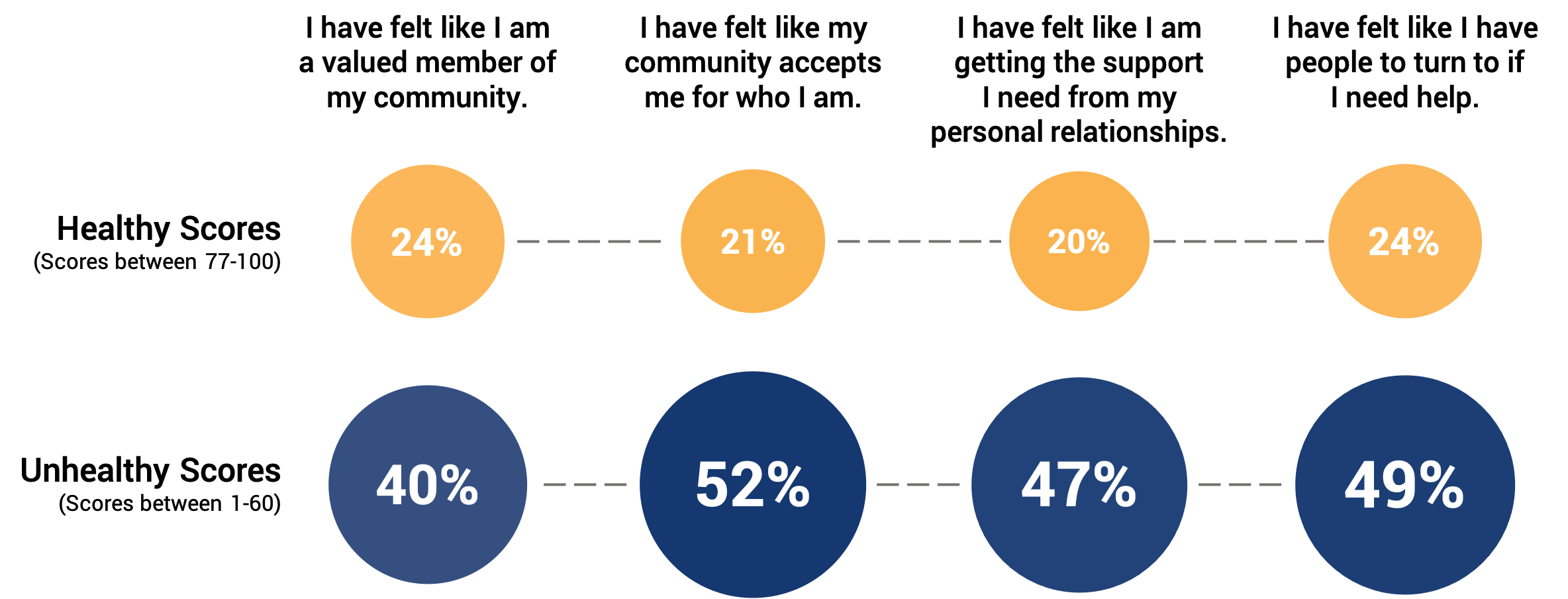
Figure 13. Percentage of respondents identifying significant mental health challenges in the past year by scores on social connection.
Across all four indicators of community and personal connection, the percentage of respondents experiencing significant mental health challenges was approximately halved when respondents felt a healthy level of connection in their community and their personal relationships. This is a significant decline and powerfully demonstrates just how influential social connection can be to our mental health.
Importantly, Figure 13 also illustrates just how complex and far-reaching COVID-19 has been. While the percentage of respondents experiencing significant mental health challenges was significantly higher for those lacking healthy social connection, we are still seeing even those with the healthiest levels of social connection struggle with their mental health – about 1 in 5. This year has affected our communities in so many ways – the pandemic has affected our finances, our work and job security, our physical health, and our parenting. We have also seen moments of pain and suffering mobilize significant social movements around social justice and equality in our communities and our nation. Our collective resilience has been repeatedly tested this year and it makes sense that we are seeing significant mental health challenges across the board.
That is why, in a year of ongoing turbulence, it would be irresponsible to suggest that social connection is the only thing our communities need. It is not. However – this data presents a strong and compelling case for why it is so important. It does not have to cost a thing to make someone feel valued, accepted, and appreciated – and yet, our data suggests that it can have a significant, uplifting impact on the number of people in our communities suffering from mental health and well-being challenges. In the next section, we will outline a call to action and some simple places that community members, leaders, and community organizations can start in order to begin the process of rebuilding social connection in our community.
Insights to Action: Mobilizing Social Connection
The results of this Special Issue Report shine a light on the significant experiences of loneliness in our communities and the mental health challenges we are seeing in its wake. It is daunting data, but we believe that sharing this data publicly is so important because even the most daunting data is good data if it can inspire action. This section is devoted to answering possibly the most important question in this report: “Now what?” How do we combat a loneliness and mental health epidemic in our communities? And what does that look like in practice?
We live in a time with more tools for connection than any other point in human history – and yet, genuine and deep connection can still feel hard to come by. COVID-19 and its associated challenges have only made this harder. As a first step, it’s important to call out some common misconceptions about what loneliness really entails. Loneliness is not just about the simple absence of others, which is why many of us have experienced a time where we’ve felt lonely in a crowded room. It’s also not about the number of connections you have, which is why the people with the most social connections can sometimes be the loneliest of us all.
Instead, loneliness is about feeling like you lack importance in the lives of others. It is about feeling like you are not appreciated or seen by those around you. Research also suggests that strong social connection is about quality more than quantity – it is possible to have a healthy level of social connection with just one very close friend and it is also possible to experience significant loneliness with 75 arms-length acquaintances.
In this section, we outline some simple actions that community members, leaders, and community organizations can do to build connection and support the well-being of those around them. This, however, might be the key takeaway for every action listed below: We cannot combat loneliness in our community without making people feel important, appreciated, and seen in the process. If we don’t start there, we will always fall short of our goal.
Where Everyone Can Start
1. Check in just to check in.
A need for more connection with friends was the most prevalent community need identified in this survey - identified by 75% of respondents. In practical terms, imagine that 75% of your friends are craving more connection right now. 3 in 4. One of the most powerful ways to signal to someone that they matter is also one of the simplest: checking in just to check in. Take this time right now to send a friend a message with no agenda, just to see how they are doing and to tell them that you are thinking of them. If you can, consider also reaching out to someone that you haven’t connected with in a while or somehow who has “gone a little quiet” – a single friend living alone, a neighbour, a co-worker. It can often be the quietest among us that need the most reassurance of just how appreciated they are and checking in just to say hello is an easy place to start. It is a simple way to signal to others that they are important enough in the lives of others to be considered, and that alone is a powerful boost to mental health. Want to take this one step further? Set an alert in your calendar to do this once a week or more for the next few months. Every little bit counts and sometimes a little reminder is all it takes.
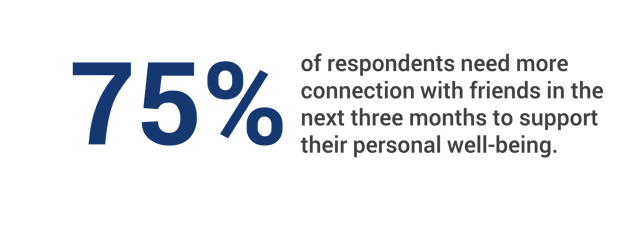
2. Acts of kindness.
There is a wide body of research demonstrating how acts of kindness can be one of the most powerful ways to combat loneliness in our communities. This can be anything from running an errand for a busy friend, to paying for a stranger’s coffee in line, to baking for a neighbour, to simply saying a heartfelt thank you to an essential worker. Acts of kindness do not have to be big, time-consuming, or expensive – for example, one particularly effective act of kindness is to write a message to a friend, colleague, or community member outlining something you appreciate about them and why you consider it so meaningful. Acts of kindness are a great way to signal to others that they matter, and here is the kicker: research suggests that they are a powerful way to combat loneliness in the giver too. They help make you feel connected to others in the process. The case is pretty clear. What is one thing you can do today to make someone’s day? Try it today - and you’ll find that you’re making your own day in the process.
3. Be aware of the mental health supports in your community.
This report has highlighted the depth of mental health challenges in our community: 32% of all respondents have experienced significant mental health challenges in the past year and 24% identified a need for more mental health supports in the next three months. Our data suggests that loneliness has played a big role in these mental health challenges, but importantly, it also suggests that you are not alone in your struggles. In our community, most mental health organizations have catered their services to directly target feelings of loneliness and other pandemic-related concerns. If possible, ask your employer what resources are available through potential health benefits – many local organizations provide access to Employee Assistance Programs with a wide breadth of counselling options. For those without access to EAP benefits, the following links provide a comprehensive list of mental health resources in our communities:
- Counselling Collaborative of Waterloo Region
- Resources in Waterloo Region
- Resources in Guelph and Wellington County
- Resources in Stratford and Perth County
Where Leaders Can Start
1. Check in just to check in, at work.
This may feel like déjà vu, but simple check ins are equally as important in your professional life as they are in your personal life. With so many people working remotely during the pandemic, the ability to maintain connection with colleagues has been strained as the proverbial water cooler has been replaced with impersonal Zoom calls and eating lunch alone. 48% of respondents working from home identified a need for more connection with their colleagues at work and we see this clearly in our data at YMCA WorkWell too. Since our inception in July 2020, our team has collected well-being data from thousands of employees in our community in a wide range of industries and organization sizes. Across all this data, a need for more personal connection at work has been the second highest need identified by employees in the last year, second only to more leadership communication. What does this mean for you as a leader? Check in with your employees when you can. Schedule 10-minute chats with your employees just to check in, understand how they are doing, and identify if there are any specific supports they need. Even if they do not need additional supports, simply being asked regularly will help signal to your team that they are valued and appreciated and will also help you connect with them in the process.
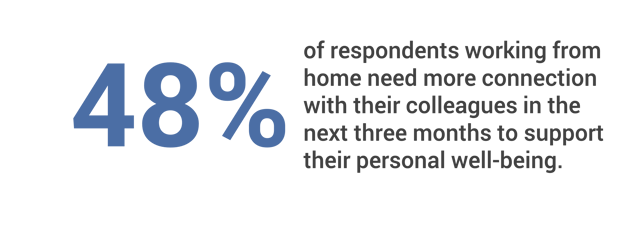
2. Say “thank you” and explain the why.
Loneliness is about feeling like you do not matter in the lives of others. We see this in our YMCA WorkWell data as well. Two of the strongest and most consistent predictors of employee well-being in our data are feeling valued and feeling appropriately recognized at work. We frequently see employees asking to simply be thanked and appreciated for their efforts at work, especially when they are facing so many challenges in their daily lives. This is why one of the simplest places to start is to genuinely say “thank you” and say it often – and this is where context is critical. A recent study by Shawn Achor and colleagues suggests that the single most impactful leadership behaviour to combat loneliness is building a shared sense of meaning with your employees. This is why it is so important to “explain the why”. When you say thank you, always try to communicate why their efforts are so meaningful to you and the larger team, and why they as a person are so appreciated. This simple addition builds shared meaning and connects them to you, to the team, and to a purpose that is larger than them. And remember: you do not have to be a leader at work to thank someone for their efforts. Who is someone that you should thank today?
3. Lead by example.
Leaders often feel like they need to be seen as unshakeable, believing that what inspires employees the most is seeing a strong hero at the top who is never phased by challenges and change. If there is one leader behaviour that this past year has called into question, it is this one. 78% of our respondents believe that COVID-19 has had a negative impact on their personal well-being, and this number is scarily high across all working groups: 79% of those working full-time from home, 81% of essential workers, 87% of those working part-time from home, and 80% of those on temporary leave. The simple odds are that your employees’ well-being has been shaken this past year and your well-being as a leader has been shaken too. One of the most significant mental health challenges is the feeling that you are struggling alone. As a leader, you are a role model in your organization. By voicing your own vulnerability at the right times, you signal to others that it is okay to not be okay, you give others the courage and permission to be vulnerable too, and you create opportunities within your team for two-way support that may not exist otherwise. It is through these cultures of authenticity that employees can feel supported, seen, and connected to something larger than themselves. Don’t underestimate the importance of your personal role in building that culture.
Where Community Organizations Can Start
1. Be Purposeful with Social Connection.
For many community organizations, social connection came easily pre-pandemic. Our YMCA is no different; the YMCA has been a hub for community connection for 150 years, but when our buildings are locked down, many of our members lose the physical facilities they have so often turned to for important face-to-face interactions. We know we are not alone in this challenge and as loneliness continues to impact our residents, community organizations need to meet their people where they are with a purposeful goal of promoting social connection. We have taken many steps to incorporate social connection into our virtual programming at the YMCA – for example, our Health Management programs like Rock Steady Boxing, an ongoing boxing class catered for members with Parkinson’s, were forced to move online at the beginning of the pandemic and the members of these cohorts lost an important source of weekly social connection. So we adapted. We began offering free social sessions online each week to help participants feel more connected to their cohort and now months later, 86% of Rock Steady Boxing participants believe that these virtual classes have helped them feel less lonely during lockdown. There is a connection gap in our community right now and community organizations need to be purposeful in how we integrate connection back into an ever-changing world. It all starts with meeting people where they are and providing opportunities to connect with others in meaningful ways.
2. Understand Your Community’s Unique Needs.
At YMCA WorkWell, we believe in the importance of disaggregated data - data that highlights trends across different populations and groups. As community organizations continue to identify the most effective ways to help their community, it is imperative that they collect the right data to best understand their own community’s unique needs. The results of this survey highlight just how important disaggregated data can be. For example, 24% of all respondents identified a need for more cultural events to build connection in the next three months; however, this need was identified by 45% of respondents from a visible minority. 32% of all respondents identified themselves as experiencing significant mental health challenges in the past year; however, this stressor was identified by 64% of LGBTQ2S+ respondents compared to 29% of straight respondents. Relying solely on community-level data can mask the true magnitude of challenges faced by certain populations. To ensure that you are effectively meeting the connection and mental health needs of the specific communities you serve, you need to begin by truly understanding what their unique needs are. If you are interested in how this loneliness or well-being data looks for your own communities, please reach out to our team at YMCA WorkWell. We care about data-driven impact and we are always happy to help.
3. Protect the Vulnerable.
It is important to remember that loneliness is often an invisible problem. We simply can’t see those that we can’t see. As our communities eventually begin to recover from the effects of COVID-19, it is imperative that we do not leave behind the most vulnerable in the process. Our data suggests that this past year has had the biggest impact on connection and mental health within some of the most vulnerable groups in our communities such as low income and hourly employees, marginalized groups, at-risk youth, and single parents. It is important to remember that because of the systemic forces working against them, these groups often have the greatest need but the least access to critical services like mental health resources in our communities. As community organizations continue to respond to the connection and mental health needs of our community, we must continue to find new and impactful ways to support the most vulnerable. We will have failed if we move forward out of the pandemic without diligently supporting them along the way. It is a critical part of our mission at the YMCA and we hope that you will join us.
We’re Here for Good
For more than 150 years, the YMCA has been devoted to building healthy and connected communities across our Three Rivers communities (Guelph, Stratford-Perth, and Waterloo Region). As a charitable organization, our aim is to create a positive and lasting impact on the communities we serve.
Throughout our history, we’ve worked to ensure that our programming and services meet our communities where they’re at. Now, more than ever, your communities, your Y, needs you.
This data underscores why we’re here. This is our commitment. To be here for good. To build stronger, more vibrant, healthier communities – one connection at a time. But, we can only do it with your support.
We need you to keep showing up with us. To continue meeting our communities’ needs. To continue building safe, welcoming spaces to learn, grow, thrive, and connect. Not just today. But every day.
Think of all the good we’ve done. Now, imagine all the good we can do, together. Learn more about how to support our Y: ThisIsY.ca/Donate.
Appendix
Appendix A: List of Community Needs Provided
Of the following, what do you need more of in the next three months to support your personal well-being? (Please select any and all that apply)
| Child care options that are accessible Child care options that are affordable Clarity around my community’s COVID-19 protocols Clarity around my workplace’s COVID-19 protocols Community centres that are accessible Connection with my friends Connection with my family Connection with my colleagues Connection with my community Cultural events Employment supports Equity, Diversity, and Inclusion programs Green space that is accessible |
Financial supports Fitness options that are accessible Fitness options that are affordable Housing options that are affordable Job security More empathetic leaders at work Mental health supports Settlement supports Someone to talk to Transit options that are accessible Transit options that are affordable Work-life balance Other (please specify) |
Appendix B: Top 12 Community Needs as Identified by Respondents
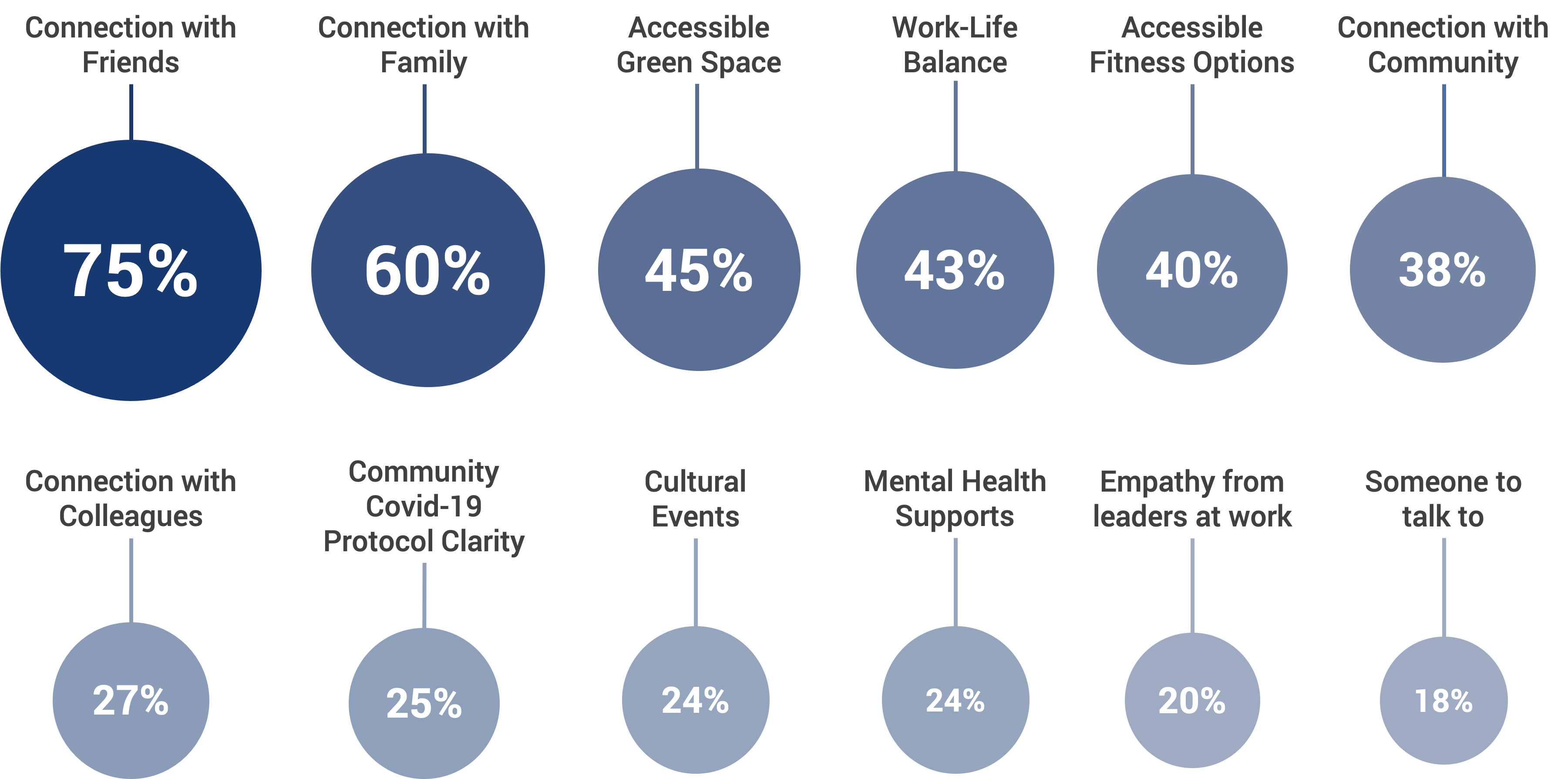
Appendix C: List of Stressors Provided
Have you experienced any of the following significant life stressors in the past year? (Please select any and all that apply)
| Birth or adoption of a child Cared for a parent or elderly family member Experience of personal discrimination Experience of personal harassment Loss of a job Loss of an immediate family member Loss of an extended family member or friend Managing a child’s education at home Moved to a new home Major Personal Illness – COVID-19 Major Personal Illness - Other |
Major Family Illness – COVID-19 Major Family Illness - Other Retirement Significant financial challenges Significant mental health challenges Significant physical health challenges Started a new job Unsuccessful bids for homes Wedding or major life event Wedding or major life event cancelled Other (please specify) |
Book Your Free 30-Minute Consultation

A Proud Part of the YMCA of Three Rivers
250 Hespeler Rd, Cambridge, ON
Contact us: workwell@ytr.ymca.ca